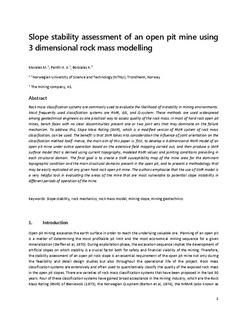| dc.contributor.author | Morales, Mario Orlando Cardenas | |
| dc.contributor.author | Panthi, Krishna Kanta | |
| dc.contributor.author | Botsialas, Konstantinos | |
| dc.date.accessioned | 2019-08-08T07:33:07Z | |
| dc.date.available | 2019-08-08T07:33:07Z | |
| dc.date.created | 2017-11-21T12:57:26Z | |
| dc.date.issued | 2019 | |
| dc.identifier.citation | Bulletin of Engineering Geology and the Environment. 2019, 78 1249-1264. | nb_NO |
| dc.identifier.issn | 1435-9529 | |
| dc.identifier.uri | http://hdl.handle.net/11250/2607502 | |
| dc.description.abstract | Rock mass classification systems are commonly used to evaluate the likelihood of instability in mining environments. Most frequently used classification systems are the rock mass rating (RMR), geological strength index (GSI), and the Q-system. These methods are used widespread among geotechnical engineers as one practical way to assess quality of the rock mass. In most hard rock open pit mines, bench faces with no clear discontinuities present one or two joint sets that may dominate on the failure mechanism. To address this, slope mass rating (SMR), which is a modified version of the RMR system of rock mass classification, can be used. The benefit is that SMR takes into consideration the influence of joint orientation on the classification method itself. Hence, the main aim of this paper is: first, to develop a three-dimensional RMR model of an open pit mine under active operation based on the extensive field mapping carried out, and then produce an SMR surface model that is derived using current topography, modeled RMR values and jointing conditions prevailing in each structural domain. The final goal is to create an SMR susceptibility map of the mine area for the dominant topographic condition and the main structural domains present in the open pit, and to present a methodology that may be easily replicated at any given hard rock open pit mine. The authors emphasize that the use of an SMR model is a very helpful tool in evaluating the areas of the mine that are most vulnerable to potential slope instability in different periods of operation of the mine. | nb_NO |
| dc.language.iso | eng | nb_NO |
| dc.publisher | Springer Verlag | nb_NO |
| dc.title | Slope stability assessment of an open pit mine using three-dimensional rock mass modeling | nb_NO |
| dc.type | Journal article | nb_NO |
| dc.type | Peer reviewed | nb_NO |
| dc.description.version | acceptedVersion | nb_NO |
| dc.source.pagenumber | 1249-1264 | nb_NO |
| dc.source.volume | 78 | nb_NO |
| dc.source.journal | Bulletin of Engineering Geology and the Environment | nb_NO |
| dc.identifier.doi | https://doi.org/10.1007/s10064-017-1175-4 | |
| dc.identifier.cristin | 1516636 | |
| dc.description.localcode | This is a post-peer-review, pre-copyedit version of an article published in [Bulletin of Engineering Geology and the Environment]. The final authenticated version is available online at: https://doi.org/10.1007/s10064-017-1175-4 | nb_NO |
| cristin.unitcode | 194,64,90,0 | |
| cristin.unitname | Institutt for geovitenskap og petroleum | |
| cristin.ispublished | true | |
| cristin.fulltext | original | |
| cristin.qualitycode | 2 | |
